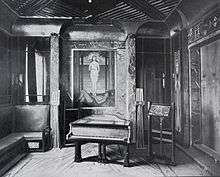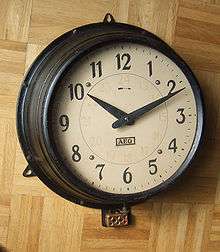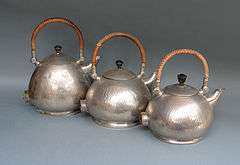Peter Behrens
| Peter Behrens | |
|---|---|
 Portrait of Peter Behrens by Max Liebermann | |
| Born |
14 April 1868 Hamburg |
| Died |
27 February 1940 (aged 71) Berlin |
| Nationality | German |
| Occupation | Architect |
| Buildings | AEG Turbine Factory |
| Projects | Deutscher Werkbund |
Peter Behrens (14 April 1868 – 27 February 1940) was a German architect and designer. He was important for the modernist movement, and several of the movement's leading names (including Ludwig Mies van der Rohe, Le Corbusier and Walter Gropius) worked for him in earlier stages of their careers.
Biography





Behrens attended the Christianeum Hamburg from September 1877 until Easter 1882. He studied painting in his native Hamburg, as well as in Düsseldorf and Karlsruhe, from 1886 to 1889. In 1890, he married Lilly Kramer and moved to Munich. At first, he worked as a painter, illustrator and book-binder in a sort of artisanal way. He frequented the bohemian circles and was interested in subjects related to the reform of life-styles. In 1899 Behrens accepted the invitation of the Grand-duke Ernst-Ludwig of Hesse to be the second member of his recently inaugurated Darmstadt Artists' Colony, where Behrens built his own house and fully conceived everything inside the house (furniture, towels, paintings, pottery, etc.) The building of this house is considered to be the turning point in his life, when he left the artistic circles of Munich and moved away from the Jugendstil towards a sober and austere style of design.
He was one of the leaders of architectural reform at the turn of the century and was a major designer of factories and office buildings in brick, steel and glass. In 1903, Behrens was named director of the Kunstgewerbeschule in Düsseldorf, where he implemented successful reforms. In 1907, Behrens and ten other people (Hermann Muthesius, Theodor Fischer, Josef Hoffmann, Joseph Maria Olbrich, Bruno Paul, Richard Riemerschmid, Fritz Schumacher, among others), plus twelve companies, gathered to create the German Werkbund. As an organization, it was clearly indebted to the principles and priorities of the Arts and Crafts movement, but with a decidedly modern twist. Members of the Werkbund were focused on improving the overall level of taste in Germany by improving the design of everyday objects and products. This very practical aspect made it an extremely influential organization among industrialists, public policy experts, designers, investors, critics and academics. Behrens' work for AEG was the first large-scale demonstration of the viability and vitality of the Werkbund's initiatives and objectives.

In 1907, AEG (Allgemeine Elektrizitäts-Gesellschaft) retained Behrens as artistic consultant. He designed the entire corporate identity (logotype, product design, publicity, etc.) and for that he is considered the first industrial designer in history. Peter Behrens was never an employee for AEG, but worked in the capacity of artistic consultant. In 1910, Behrens designed the AEG Turbine Factory. From 1907 to 1912, he had students and assistants, and among them were Ludwig Mies van der Rohe, Le Corbusier, Adolf Meyer, Jean Kramer and Walter Gropius (later to become the first director of the Bauhaus). From 1920 and 1924, he was responsible for the design and construction of the Technical Administration Building (Technische Verwaltungsgebäude) of Hoechst AG in Höchst. In 1922, he accepted an invitation to teach at the Academy of Fine Arts Vienna. Peter Behrens remained head of the Department of Architecture at the Prussian Academy of Arts in Berlin. In 1926, Behrens was commissioned by the Englishman Wenman Joseph Bassett-Lowke to design him a family home in Northampton, UK. The house, named 'New Ways' is often regarded as the first modernist house in Britain.
In 1928 Behrens won an international competition for the construction of the New Synagogue, Žilina. The building survives as a cultural centre.[1]
In 1936 Behrens was called from Vienna to conduct a Master class in architecture, in succession to Hans Poelzig, at the Prussian Academy of Arts (now the Akademie der Künste) in Berlin, reportedly with the specific approval of Hitler. Behrens became associated with Hitler's urbanistic dreams for Berlin with the commission for the new headquarters of the AEG on Albert Speer's famous planned north-south axis. Speer reported that his selection of Behrens for this commission was rejected by the powerful Alfred Rosenberg, but that his decision was supported by Hitler who admired Behrens's Saint Petersburg Embassy. Behrens and the academy helped his cause by reporting to the Ministry that Behrens had joined the then illegal Nazi party in Austria on May Day of 1934. The vast AEG building with its marshalled fenestrations and detailing, like the project of which it was a part, was not built. Behrens died in Hotel Bristol in Berlin on 27 February 1940, while seeking refuge there from the cold of his country estate.[2]
Typefaces Designed by Peter Behrens
All faces cast by the Klingspor Type Foundry.
- Behrens-Schrift (1901-7)
- Behrens-Antiqua (1907-9)
- Behrens Mediaeval (1914)
References
- notes
- Sources
- Borský, Maroš (2007). Synagogue Architecture in Slovakia: Towards Creating a Memorial Landscape of Lost Community. PhD dissertation, Hochschule für Jüdische Studien, Heidelberg. Accessed 23 November 2014.
- A. Windsor (1981): Peter Behrens: Architect and Designer, Humanities Press Intl; First US edition, ISBN 0-85139-072-2
- Stanford Anderson (2002): Peter Behrens and a New Architecture for the Twentieth Century, The MIT Press, ISBN 0-262-51130-4 ISBN 978-0262511308
- Peter Behrens (1990): Peter Behrens: Umbautes, Licht Prestel Pub, ISBN 3-7913-1059-3 (German edition)
- Kathleen James-Chakraborty (2000): German architecture for a mass audience, Routledge, ISBN 0-415-23654-1
- Ina Bahnschulte-Friebe: Künstlerkolonie Mathildenhöhe Darmstadt 1899–1914. Darmstadt: Institut Mathildenhöhe 1999, ISBN 3-9804553-6-X (German)
- Georg Krawietz: "Peter Behrens im dritten Reich", Weimar 1995, VDG, Verlag und Datenbank für Geisteswissenschaften, ISBN 3-929742-57-8 (German)
- Klaus J. Sembach: 1910 – Halbzeit der Moderne. Stuttgart: Hatje 1992, ISBN 3-7757-0392-6 (German)
External links
| Wikimedia Commons has media related to Peter Behrens. |
- Virtual gallery with Behrens designs for AEG
- The synagogue of Zilina, Slovakia designed by Peter Behrens
- Neolog Synagogue in Žilina Attached plaque: “This synagogue was built by the world famous architect Peter Behrens, in 1933–1934, on the same site as the original synagogue built in 1881. It served as a place of Jewish worship until the arrival of facism. World War II tragically affected the lives of the Slovak Jews, at the time 3,600 Jewish people helped make up the 19,000 population of Žilina. After the war, only 500 Jewish survivers returned. Since the end of war, the building has been used for cultural and educational purposes by the city and as a technical college. Jewish congregation of Žilina 1934–1996.”
- The Schiedmayer grand piano from the musicroom of the House Behrens 1901